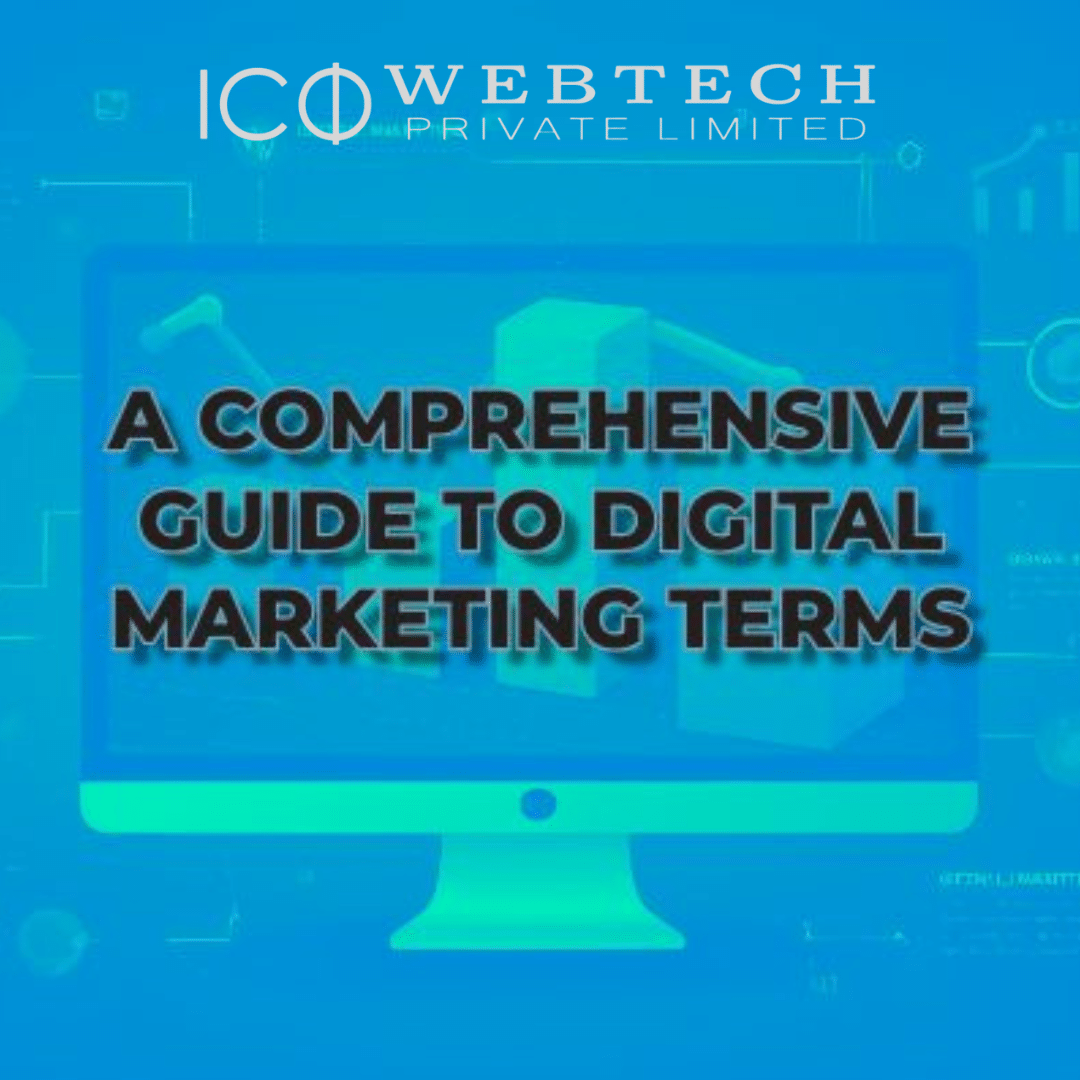The digital marketing landscape can feel overwhelming for newcomers, filled with jargon and acronyms. But fear not! This guide will equip you with a solid understanding of the most common terms used in digital marketing, giving you the confidence to navigate this exciting field.
- SEO (Search Engine Optimization): SEO is the process of optimizing your website to improve its visibility in search engine results pages (SERPs). This involves optimizing various elements of your site, including content, meta tags, and backlinks, to rank higher for relevant keywords. The goal of SEO is to increase organic (non-paid) traffic to your website and enhance its overall visibility online.
- SEM (Search Engine Marketing): SEM refers to the use of paid advertising to increase a website’s visibility in search engine results. It includes strategies like pay-per-click (PPC) advertising, where advertisers bid on keywords to display their ads prominently in search engine results. SEM complements SEO efforts by providing immediate visibility for targeted keywords, albeit at a cost.
- PPC (Pay-Per-Click): PPC is an advertising model where advertisers pay a fee each time their ad is clicked. It’s commonly associated with search engine advertising, social media platforms, and display advertising networks. PPC campaigns can be highly targeted, allowing advertisers to reach specific demographics and track the performance of their ads in real time.
- CTR (Click-Through Rate): CTR is a metric that measures the percentage of people who click on an ad or a link compared to the total number of impressions. It’s a crucial indicator of ad performance and relevance. A high CTR indicates that the ad is resonating with the target audience, while a low CTR may suggest that adjustments are needed to improve its effectiveness.
- CMS (Content Management System): A CMS is a software platform that allows users to create, manage, and publish digital content on the web. Popular CMS platforms include WordPress, Drupal, and Joomla. These systems provide an intuitive interface for managing website content, making it easier for businesses to update their sites regularly with fresh and relevant content.
- ROI (Return on Investment): ROI is a performance metric that evaluates the profitability of an investment relative to its cost. In digital marketing, ROI is typically calculated by comparing the revenue generated from marketing efforts to the cost of those efforts. A positive ROI indicates that the marketing campaign is generating more revenue than it costs to run, while a negative ROI suggests that adjustments are needed to improve profitability.
- CTR (Content Marketing): Content marketing involves creating and distributing valuable, relevant, and consistent content to attract and engage a target audience. This content can take various forms, including blog posts, videos, infographics, and whitepapers. The goal of content marketing is to build brand awareness, establish thought leadership, and ultimately drive profitable customer action.
- SMM (Social Media Marketing): SMM involves using social media platforms like Facebook, Twitter, Instagram, and LinkedIn to promote a brand’s products or services. It encompasses creating and sharing content, engaging with followers, and running paid advertising campaigns. Social media marketing enables businesses to connect with their audience on a more personal level and foster meaningful relationships.
- KPIs (Key Performance Indicators): KPIs are measurable values that indicate the success of a marketing campaign or strategy. They vary depending on the specific goals and objectives of the campaign but often include metrics like website traffic, conversion rate, engagement rate, and customer lifetime value. By tracking KPIs, marketers can assess performance, identify areas for improvement, and make data-driven decisions to optimize their marketing efforts.
- CTA (Call to Action): A CTA is a prompt that encourages users to take a specific action, such as signing up for a newsletter, downloading a whitepaper, or making a purchase. CTAs are typically placed strategically within marketing materials, such as landing pages, emails, and ads, to guide users through the conversion process. Effective CTAs are clear, compelling, and relevant to the user’s needs and interests.
- A/B Testing: A/B testing, also known as split testing, is a method of comparing two versions of a web page, email, or ad to determine which one performs better in terms of engagement or conversion rate. By testing different elements such as headlines, images, or CTAs, marketers can identify the most effective strategies for driving user action and optimizing campaign performance.
- UGC (User-Generated Content): UGC refers to any form of content, such as reviews, testimonials, photos, or videos, created by users or customers rather than the brand itself. It’s a powerful tool for building trust and credibility, as potential customers are more likely to trust the opinions and experiences of their peers. Incorporating UGC into marketing campaigns can help increase engagement, drive conversions, and strengthen brand loyalty.
- CRM (Customer Relationship Management): CRM software is a tool used by businesses to manage and analyze interactions with current and potential customers. It stores customer data, tracks communication history, and facilitates targeted marketing campaigns and personalized outreach. By leveraging CRM technology, businesses can improve customer satisfaction, streamline sales processes, and drive long-term loyalty.
- GDPR (General Data Protection Regulation): GDPR is a comprehensive data privacy regulation that governs how businesses collect, process, and store the personal data of individuals within the European Union (EU). It imposes strict requirements on companies to obtain explicit consent for data collection, provide transparency about data practices, and implement robust security measures to protect customer information. Compliance with GDPR is essential for businesses operating in the EU or targeting EU customers to avoid hefty fines and reputational damage.
- Segmentation: It involves dividing a target audience into smaller, more manageable groups based on shared characteristics or behaviors. Marketers use segmentation to deliver personalized messages and offers tailored to the specific needs and preferences of each segment. Segmentation can be based on demographics, psychographics, purchase history, or engagement level, allowing marketers to maximize relevance and effectiveness in their campaigns.
- Remarketing/Retargeting: Remarketing, also known as retargeting, is a digital advertising strategy that targets users who have previously interacted with a brand’s website or mobile app but did not complete a desired action, such as making a purchase. By tracking user behavior through cookies or pixels, marketers can display targeted ads to these users as they browse other websites or social media platforms, reminding them of the brand and encouraging them to return and convert.
- Landing Page: A landing page is a standalone web page created specifically for a marketing campaign or promotion. It’s designed with a single focus or call-to-action (CTA) to prompt visitors to take a desired action, such as signing up for a webinar, downloading an ebook, or making a purchase. Landing pages are optimized for conversion and often feature compelling headlines, persuasive copy, relevant imagery, and clear CTAs to maximize engagement and drive conversions.
- Lead Magnet: A lead magnet is a valuable piece of content or incentive offered to prospects in exchange for their contact information, typically their email address. Common types of lead magnets include ebooks, whitepapers, case studies, templates, or free trials. By providing valuable resources or solutions to prospects’ pain points, marketers can attract leads and nurture them through the sales funnel, ultimately converting them into customers.
- Influencer Marketing: Influencer marketing involves partnering with individuals or personalities with a large and engaged following on social media to promote a brand’s products or services. Influencers leverage their credibility, authority, and trust with their audience to endorse and recommend brands authentically. Marketers collaborate with influencers to reach new audiences, increase brand awareness, and drive conversions through sponsored content, product placements, or affiliate partnerships.
- SERP (Search Engine Results Page): SERP is the page displayed by search engines in response to a user’s query, listing relevant websites, ads, featured snippets, and other search results. Marketers aim to improve their website’s ranking and visibility in SERPs through search engine optimization (SEO) techniques, including keyword optimization, content creation, and link building, to attract organic traffic and drive conversions.
- Churn Rate: Churn rate is a metric that measures the percentage of customers or subscribers who stop using a product or service within a specific period, typically a month or a year. High churn rates can indicate dissatisfaction with the product or service, poor customer experience, or ineffective retention strategies. Marketers analyze churn rate to identify reasons for customer attrition and implement targeted efforts to reduce churn and improve customer retention.
- Impression: This refers to the number of times your ad is displayed, regardless of whether someone clicks on it. Think of it as the number of people who glanced at your advertisement on the street, even if they didn’t stop to explore your store.
- Email Marketing: This involves sending targeted emails to promote your products or services, build relationships with customers, and nurture leads (potential customers who have shown some interest). It’s a permission-based marketing approach, allowing you to connect directly with a curated audience who has opted-in to receive your communications, similar to handing out flyers or personalized coupons to interested customers.
- Email List Management: Building and maintaining a healthy email list is essential for successful email marketing. This involves collecting email addresses from website visitors who have opted in to receive your communications, ensuring you have a permission-based audience and following best practices to avoid spam filters.
- ROI (Return on Investment): This metric is all about measuring the profitability of your marketing campaigns. It’s calculated by dividing the revenue generated by your campaign by the total cost of the campaign. Just like any business owner, you want to understand how much return you’re getting on your investment in marketing efforts.
- Metrics: These are the measurable data points used to track the performance of your marketing campaigns. In digital marketing, metrics can include website traffic, conversion rates (the percentage of visitors who take a desired action), social media engagement, and even customer satisfaction ratings. They’re like the sales figures and customer feedback that a business owner uses to gauge success.
- Analytics Tools: Platforms like Google Analytics are powerful tools that provide insights into your website traffic, user behavior, and marketing campaign effectiveness. Imagine having a team of analysts constantly monitoring your store’s foot traffic, customer behavior, and sales figures to identify areas for improvement.
- Conversion Rate: This metric is crucial! It represents the percentage of visitors who take a desired action on your website, such as purchasing, signing up for a free trial, or downloading a white paper. The higher your conversion rate, the more effective your website is at turning visitors into customers.
- CRO (Conversion Rate Optimization): This is the ongoing process of improving your website and marketing efforts to increase conversion rates. It’s like constantly refining your store’s layout, product displays, and sales techniques to encourage more customers to make a purchase.
- Engagement: This refers to the level of interaction your content receives on social media. Likes, comments, shares, and mentions are all signs of a healthy online presence, just like lively conversations with potential customers demonstrate their interest in what you have to offer.
- Content Marketing: This is the art of creating and sharing valuable, informative content (blogs, articles, videos, infographics, etc.) that attracts and engages your target audience. Think of it as providing helpful resources and establishing yourself as a thought leader in your industry, just like a friendly salesperson offering informative advice to potential customers.
- Content Strategy: A well-defined content strategy is your roadmap. It outlines the type of content you’ll create, how you’ll distribute it, and how it aligns with your overall marketing goals.
- Traffic Source: Just like in a physical store, you want to know where your customers come from. In digital marketing, traffic sources tell you where your website visitors originate from. This could be organic search, referrals from social media platforms, paid advertising clicks, or even people directly typing your website address (direct traffic).
- Bounce Rate: This metric indicates the percentage of visitors who leave your website after viewing only one page. A high bounce rate suggests a need to improve your website’s user experience or ensure your content is relevant to the keywords used to find you.
- Heatmap Analysis: Heatmap analysis is a data visualization technique used to analyze user behavior and interaction patterns on a website or landing page. Heatmaps display areas of high and low user activity through color-coded overlays, such as clicks, scrolls, and mouse movements. Marketers use heatmap analysis to identify areas of interest, navigation bottlenecks, and user preferences, informing website optimization, user experience design, and conversion rate optimization (CRO) efforts.
- Marketing Automation: Marketing automation refers to the use of software platforms and technologies to automate repetitive marketing tasks, workflows, and campaigns across multiple channels, such as email, social media, and lead nurturing. Marketing automation enables marketers to streamline processes, personalize communications, and nurture leads at scale, leading to increased efficiency, improved targeting, and higher ROI. Common marketing automation tools include HubSpot, Marketo, and Mailchimp.
- Evergreen Content: Evergreen content is timeless, high-quality content that remains relevant and valuable to readers over an extended period. Unlike topical or time-sensitive content, evergreen content addresses fundamental questions, problems, or interests within a niche or industry and continues to attract traffic and engagement long after it’s published. Marketers invest in creating evergreen content to drive consistent organic traffic, build authority, and nurture leads over time, contributing to long-term SEO and content marketing strategies.
- Domain Authority (DA): Domain authority (DA) is a metric developed by Moz that predicts a website’s ability to rank in search engine results pages (SERPs). DA is based on factors such as the quantity and quality of backlinks, domain age, content relevance, and overall website authority. Marketers use DA as a benchmark to evaluate the credibility and SEO performance of their websites, as well as to identify opportunities for link building and improving search visibility.
- Exit Intent Pop-ups: Exit intent pop-ups are overlay messages or offers that appear on a website when a user attempts to leave the page, typically by moving their cursor toward the browser’s navigation bar. These pop-ups aim to re-engage visitors and prevent them from abandoning the site by presenting compelling offers, discounts, or incentives to encourage them to stay or take a specific action, such as subscribing to a newsletter or making a purchase. Marketers leverage exit intent pop-ups to reduce bounce rates, capture leads, and increase conversions.
- Cost Per Acquisition (CPA): Cost per acquisition (CPA) is a digital advertising metric that measures the average cost incurred to acquire a new customer or lead through paid marketing channels. CPA is calculated by dividing the total advertising spend by the number of conversions generated. Marketers use CPA to evaluate the efficiency and profitability of their advertising campaigns and allocate budgets effectively to achieve their desired acquisition goals.


